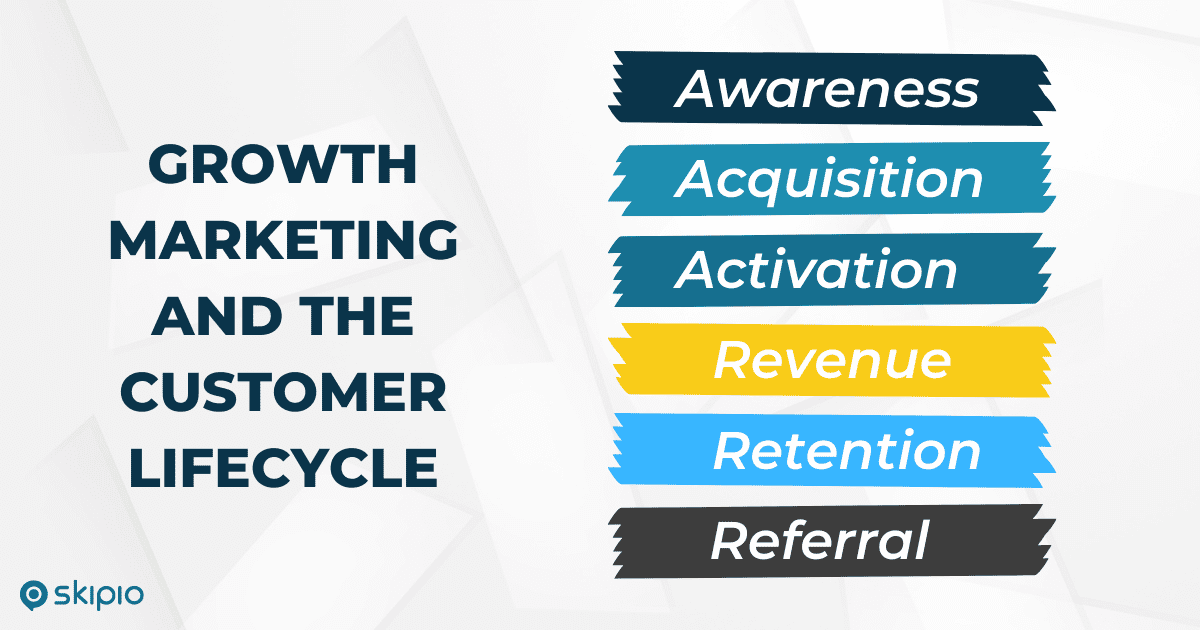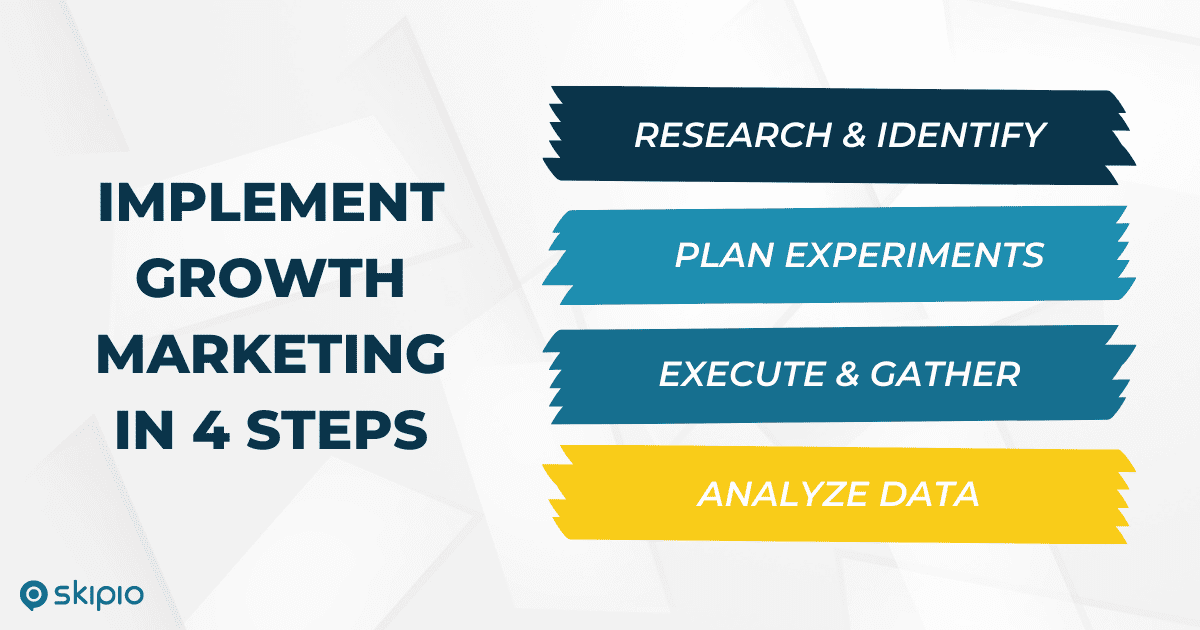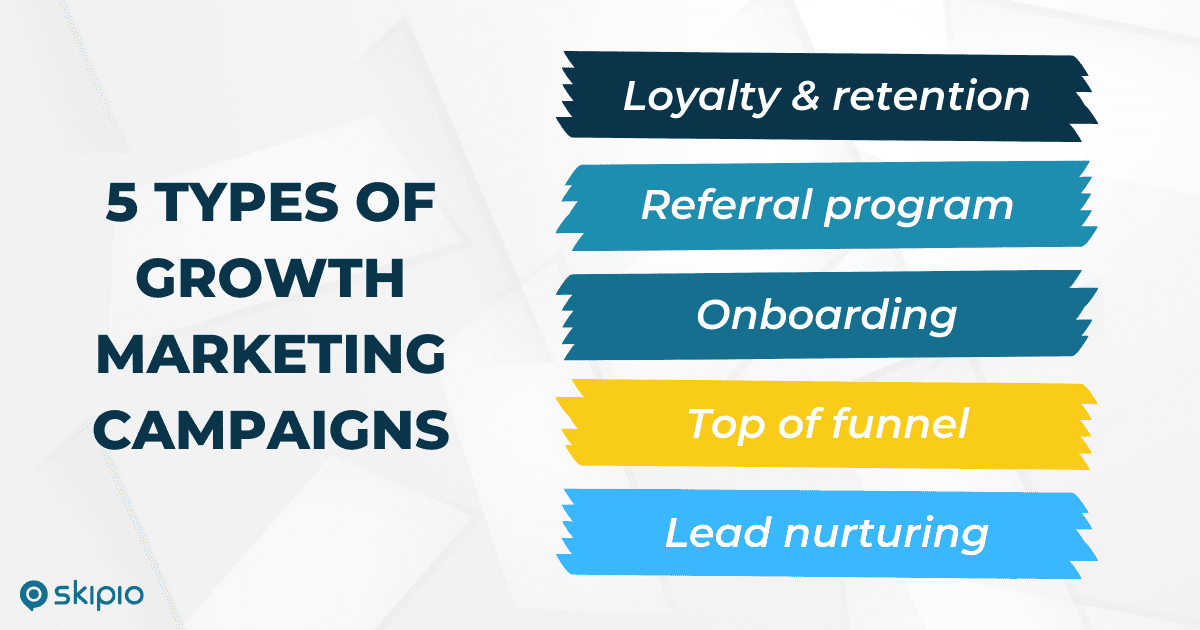
A lot of marketing’s impact can’t be reduced to numbers and data. Not everything needs to be measured either, and pretending otherwise is a silly choice. But all this really means is that you need to measure what matters.
For all the marketing data nerds out there, plenty exists to research, test, and measure. At least, there is when you prioritize growth marketing.
Core components of growth marketing strategies
Basic steps to implement growth marketing
Examples of growth marketing campaigns
Combine growth marketing with all your efforts
What is growth marketing?
In growth marketing, you examine the entire customer lifecycle and experiment to improve the customer experience. In turn, you improve revenue and profits. The goal? Create more engaged customers who not only feel confident in buying from you sooner but then stick around longer.
You hone in on controllable, quantifiable variables that influence people to choose your solutions (again and again).
Core components of growth marketing strategies
Your growth marketing campaigns will take many forms, but the foundation of your overall strategy should include certain core components. Become an expert in these three areas (or make sure someone on your team is) and your growth marketing succeeds.
Customer lifecycle
Surprise! The majority of the customer lifecycle exists post-purchase. Growth marketing only works when you’re totally familiar with every stage and dedicate time to improving each one. Getting new customers is important, but keeping your current ones is an even bigger deal.

Now known by many as the pirate metrics, you need to align marketing and sales within each of these parts of the customer journey to see success with growth marketing tactics. Within these areas you plan and execute your tests and experiments, gathering data that helps you make better decisions about your future marketing and sales tactics.
- Awareness: Brand awareness and general education
- Acquisition: Lead gen, capture, and nurturing (everything before someone buys)
- Activation: Sign-up, purchase, and onboarding
- Revenue: Customer monetization, including upgrades and cross-selling
- Retention: Customer engagement and satisfaction (everything after someone buys)
- Referral: Brand advocacy and support
Some people call this the market funnel, but a better analogy is a pathway. The “funnel” mindset can create the illusion that you need to spend more time or effort at the “top” or beginning to keep the “bottom” full. This is where growth marketers really shine.
For instance, getting referrals is not only easier with growth marketing, but also they typically become more profitable clients who stay longer. Increasing ROI doesn’t only happen at the beginning of the pathway.
If any steps in the customer lifecycle appear to bottleneck, that’s where you focus.
A/B testing
It’s the bread and butter of marketers everywhere. A/B testing allows you to identify the nitty gritty details that make a difference.
Compare photos, subject lines, button CTAs, text message length, pricing displays… You can A/B test most things. You want to see how those potentially small factors affect people’s engagement with your company.
Cross-channel marketing
You need to be everywhere your customers are, sharing and promoting content that’s clearly relevant to where it’s being shared. I know we’ve all seen when a brand is trying too hard to be ~relatable and failing miserably.
The best cross-channel marketing has a consistent message that’s still tailored to the specific channel. It feels cohesive with your overall marketing strategy and builds positive awareness for the brand.
Basic steps to implement growth marketing at your company
Fully embracing growth marketing is no small thing. It’s going to take a lot of time to get your specific process dialed in. Here’s a basic four-step process for implementing growth marketing that you can tailor to your business needs.

1. Research and identify areas of improvement
Discover the aspects of the customer lifecycle that you want to improve or change. This may either be out of necessity or simply because there’s always potential to do more.
Do you want more people upgrading within your app? Are onboarding emails not being opened? Your process for requesting reviews seems to be stalled? All of these are valid business questions you might find yourself considering.
2. Plan and develop quantifiable experiments
Prep your tests surrounding the areas of improvement. What and how you test will vary. A/B testing is going to be a huge part of this step. You have to set up what exactly you want to test and what variables matter.
At this point you also need to know how you’re going to track what you test and where that data will be stored. What parts of the tracking process will be automated or manual? How will people access it? What factors will determine the winner? How long will you run your test?
3. Execute your experiments and gather data
Put everything into action! How long you run your tests varies based on what you hope to find out. You need to do them long enough to actually prove something one way or another. Certain tests yield results fast and others will go for a while.
If you’re working on an SEO project for example, that’s not likely to be done in a couple weeks. But if you’re testing the effectiveness of two CTAs on your pricing page and you get thousands of visitors a day, you’ll get actionable results much faster.
4. Analyze results and data to make future choices
In many cases you’ll be following along closely with your data as it comes in. That’s important! But make sure you take the time to fully analyze everything within the full context of your test.
Everything you glean from your data should then inform future sales and marketing decisions. Sometimes this means knowing how to plan a better test in the future, or even that the variables you thought mattered were not important. Trial and error rules!
Seem overwhelming? Yeah, that’s fair. Break down each of these four steps and don’t try to plan experiments for every stage of the customer lifecycle all at once. Choose one or two of the “pirate metrics” to focus on and then plan/execute very specific tests as you go through the learning process.
Examples of growth marketing campaigns
Growth marketing strategies should be applied to every step in the customer journey. There are practically endless ways to implement growth marketing and run tests, so it can help to see how other businesses have had success. Here are 5 examples of campaigns you can develop and build to suit your business and audience.
Loyalty and retention
At the end of the day, all growth marketing helps you keep people longer and increase CLV. Dig into why your long-term customers keep coming back and why others churn. This requires conducting customer interviews and maintaining detailed account notes.
You may find it valuable to track and then create tests around:
- the frequency of customer follow-up
- effectiveness of promotions/sales
- methods of product education
- activity and engagement in the product
- cancellation offers and related language
- new add-ons and other cross-selling options
Referral programs
You know you’ve made it when customers can’t help but talk about you to other people. Help them along in the process of becoming brand advocates by setting up an irresistible referral program. (After you’ve created a great onboarding and engagement strategy, of course.)
Rewarding customers, like really rewarding them, for giving referrals helps you grow your customer base and contributes to higher retention.
To maximize a referral program, be ready to investigate questions like:
- How long does someone need to be a customer before they’re willing to put their own reputation on the line to recommend you to others?
- What are you giving the referee and the referral to make it worth their while?
- What’s the most effective way to request referrals: texting, emailing, calling?
- If you get a referral and they convert, what then gets them to stay?
Onboarding
Onboarding correlates directly with customer loyalty and retention. Ultimately, you need to figure out how to get customers adopting your solutions faster and with greater ease.
This type of growth marketing campaign commonly focuses on actions like:
- Providing in-app instruction through pop-ups or guides
- Encouraging actions that lead to immediate gratification or success
- Offering consultations or group training sessions
- Engaging new customers through personalized emails, text messages, and/or calls (whichever is most relevant and useful to your audience)
Top of the funnel engagement
What you do to increase brand awareness and streamline the early steps of acquisition set the tone for your entire growth marketing strategy. For most companies, this means solidifying your online or social presence and maintaining a stellar website.
Plan experiments and gather data surrounding:
- Frequency of posting on different social platforms
- Types of posts that are most effective on different social platforms (videos vs. photos as well as blog posts vs. case studies)
- Engagement on infographics versus videos or other media
- Effectiveness of different headlines or button CTAs on landing pages
- Your team’s response time to new form submissions
- Response rates to emails and texts containing the same information
Lead nurturing
When dealing with acquisition, it’s not just about lead gen. Your lead nurturing needs to really shine so that you build relationships, get the right people buying, and then keep them engaged.
You need more responses from prospects and less ghosting for appointments. To accomplish both of those things and close more sales, you’ll want to:
- Track your team’s response times for all conversations with prospects. Hopefully all the communication platforms you use make that easy. Skipio gives you that number, among other stats, on the team dashboard, for example.
- Pay attention to response rates to different types of messages — when they’re sent, what they say, how long they are, etc.
- Test different cadences for appointment reminders and post-meeting follow-up.
- Try different combinations of texting, calling, and emailing. (I’ll give you a hint: Texting needs to be a huge part of the nurturing and sales process.)

What it takes to become a growth marketer
Within growth marketing, people develop different areas of expertise, often around the stages of the customer lifecycle. But no matter where you want to focus your efforts, successful growth marketers share these priorities.
Driven by data
No surprises here. The whole idea of growth marketing is to gather data that will help you make better decisions. But being truly “data driven” means your research, testing, and results all need to be carefully analyzed and evaluated before you use any of it to justify changes.
Data sometimes shows you stuff you don’t want to know. It may reveal weaknesses you didn’t realize your company had. Be ready to check your biases and be wrong.
At the same time, numbers can lie. They can be manipulated and they can mislead. Focusing too much on “hard numbers” won’t serve you because you aren’t selling to numbers. You’re selling to people and, ideally, building relationships with them.
You need to trust your data AND question your data.
Focused on the product
You must become an expert on your own product and solutions. This isn’t about the feature set or how exactly your products work but rather what you enable people to do. So what pains are you solving and what needs are you fulfilling?
When you know those answers, you put yourself in a better position to analyze the data about what matters most to people when it comes to picking a solution.
Work with your product team and your customer success team to really understand why people choose you over competitors. Use what you learn in your experiments to help them better the product to help customers more effectively.
Possess a hacker mentality
I’ve specifically avoided the phrase “growth hacking” in this post. Did you notice? Though the terms growth hacking and growth marketing come up together in a lot of discussions, ultimately growth marketing isn’t about “hacking” anything. You’re just trying to create incredible customer experiences.
But successful growth marketers do need to have the mentality that there is always a better way to get better results. Not to be too cliche, but you want to work smarter, not harder.
Combine growth marketing with all your marketing efforts
Choosing to do growth marketing means improving the entire customer experience. But there isn’t an “all-in-one” marketing and sales strategy that solves all acquisition and customer retention problems. Growth marketing should be done in combination with other strategies, such as account-based marketing. So your growth marketing team will help those involved in ABM do it even better.
Along those same lines, don’t just apply growth marketing strategies to your current outreach and follow-up processes. If you really care about optimizing the customer experience, explore new communication methods too. For many teams, that means adopting text messaging.
Conversational texting done with Skipio fits in perfectly with teams that care about growth marketing because the platform helps you prioritize measurable growth.
Skipio gives you everything you need to get responses, build connections, and keep customers longer.
Using personalized automations that you fully control, you get potential customers to respond and engage with your brand. After you close sales, Skipio helps you automate the onboarding process in a totally human way. You improve retention by scheduling messages at key times, like automatically sending reminders before customer contracts expire.
Have more questions about using Skipio at your company to improve outreach, conversions, and retention? Schedule a demo with our team.


